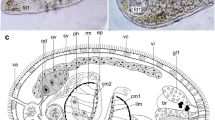Abstract
Loxokalypus socialis is a new type of Kamptozoa (Entoprocta) native to the Northern Pacific Ocean. In zooid morphology and in its larval form, it resembles the solitary loxosomatids; however, in the fact that it buds at the zooid stalk and builds small colonies, it resembles the colonial Entoprocta. It should be classified in its own new family (Loxokalypodidae) and in a new suborder (Astolonata) of the colony-building Kamptozoa (order: Coloniales). Because of the discovery of Loxokalypus, the criteria defining the families of Entoprocta should be revised. The taxonomy of this group is critically examined, and a new approach proposed to the taxonomy of Kamptozoa consistent with phylogeny. Revised criteria, in harmony with operative phylogenetic considerations, and a key for all known families and genera are presented. It is proposed that illustrations for new descriptions of entoprocts should be standardized, and that the use of microphotos for this purpose be made obligatory.
Zusammenfassung
-
1.
Loxokalypus socialis ist ein neuer Kamptozoentyp aus dem Nordpazifischen Ozean.
-
2.
Diese Art nimmt eine intermediäre Stellung zwischen solitären und koloniebildenden Kamptozoen ein: der Zooidanatomie und Larvenform nach gehört sie den Loxosomatiden an, zeigt aber eine für koloniale Entoprocten typische Individuenknospung am Zooidstiel und bildet obligatorisch kleine, individuenarme Kolonien.
-
3.
Die systematische Stellung von Loxokalypus wird diskutiert; die Art muß in einer eigenen Familie Loxokalypodidae einer neu geschaffenen Unterordnung (Astolonata) der koloniebildenden Entoprocten (Ordnung: Coloniales) zugeordnet werden.
-
4.
Die Entdeckung von Loxokalypus macht eine Neudefinition der Familienkriterien bei Entoprocten erforderlich. In diesem Zusammenhang wird die bisher gebräuchliche Entoproctensystematik kritisch betrachtet, und ein Vorschlag zu ihrer Neufassung nach phylogenetischen Gesichtspunkten zur Diskussion gestellt.
-
5.
Unter Anwendung erweiterter Gattungskriterien wird ein Bestimmungsschlüssel für alle bekannten Familien und Gattungen gegeben.
-
6.
Illustrationen zu Neubeschreibungen von Kamptozoen sollten standardisiert werden; Erstbeschreibungen sollten obligatorisch neben Zeichnungen auch Mikrophotos enthalten.
Similar content being viewed by others
Zitierte Literatur
Beklemishev, V. N.: Grundlagen der vergleichenden Anatomie der Wirbellosen, Vol. 1. 441 pp. 1. Aufl. Berlin: VEB Deutscher Verlag der Wissenschaften 1958
Du Bois-Reymond-Marous, E.: Neue Entoprocten aus der Gegend von Santos. Zool. Anz. 159, 68–75 (1957).
Brien, P.: Classe des endoproctes ou kamptozoaires. In: Traité de zoologie, Vol. 5. pp 927–1007. Ed. by P. Grasse. Paris: Masson 1959.
Busk, G.: Polyzoa. Rep. scient. Results Voyage HMS Challenger (Zool.) 17 (1886).
Clark, A. H.: A new classification of animals. Bull. Inst. océanogr. Monaco 400, 1–24 (1921).
Cori, C.: Kamptozoa. In: Handbuch der Zoologie, Vol. 2. pp 1–64. Hrsg. von W. Kükenthal und T. Krumbach. Berlin: Walter de Gruyter 1929.
—: Kamptozoa. In: Die Tierwelt der Nord- und Ostsee, Teil 4a. pp 1–68. Hrsg. von P. Grimpe und E. Wagler. Leipzig: Akad. Verlagsges. Geest & Portig 1936.
Emschermann, P.: Über Brutkörper bei dem Kamptozoon Barentsia gracilis Sars. Zool. Jb. (Allg. Zool. Physiol. Tiere) 69, 333–338 (1961).
—: Über die sexuelle Fortpflanzung und die Larve von Urnatella gracilis Leidy (Kamptozoa). Z. Morph. 55, 100–114 (1965).
— Ein Kreislauforgan bei Kamptozoen. Z. Zellforsch. 97, 576–607 (1969).
—: Loxomespilon perezi-ein Entoproctenfund im Mittelatlantik. Überlegungen zur Benthosbesiedlung der Großen Meteorbank. Mar. Biol. 9, 51–62 (1971).
Geological Survey of Canada: Report of progress for 1878–1879, Publ. by Authority of Parliament, Montreal: 1880. (zitiert nach Hincks, 1882).
Hatschek, B.: Lehrbuch der Zoologie. Jena: G. Fischer 1888.
Hincks, T.: A history of the British marine Polyzoa, 589 pp. London: John van Voorst 1880.
—: Report on the Polyzoa of the Queen Charlotte Islands. Ann. Mag. nat. Hist. (Ser. 5) 10, 459–471 (1882).
Hyman, L. H.: The invertebrates. Vol. 3. Acanthocephala, Aschelminthes and Entoprocta; the pseudocoelomate bilateria, pp 521–554. New York: McGraw Hill 1951.
Kluge, G. A.: Kamptozoa is sewernogo ledowitogo okeana. In: Trudy Dreyfuyushey Ekspedizii Glavsevmorputy na Ledokolnom Parochode G. Sedov 1937–1940, pp 149–157. Ed. by G. B. Gorbunov and P. W. Ushakov. Leningrad: Akad. Nauk. SSSR 1946.
Marcus, E.: Bryozoarios marinhos brasileiros III. Bolm. Fac. Filos. Ciênc. Univ. S Paulo (Zoologia) 3, 113–300 (1939).
Mortensen, T.: A new species of entoprocta, Loxosomella antedonis, from N. E. Greenland. Danmark-Eksped. til Grønlands Nordøstkyst 1906–1908 (V no. 8) Meddr. Grønland 45, 397–406 (1911).
Nielsen, C.: Studies on Danish Entoprocta. Ophelia 1, 1–73 (1964).
Nitsche, H.: Beiträge zur Kenntnis der Bryozoen 1–2. Z. wiss. Zool. 20, 1–36 (1870).
Osburn, R. C.: Bryozoa of the Pacific coast of America. Allan Hancock Pacif. Exped. 14, 613–773 (1953).
Prenant, M. et G. Bobin: Bryozoaires. In: Faune de France, Vol. 60. 398 pp. Paris: Lechevalier 1956.
Remane, A.: Die Grundlagen des natürlichen Systems der vergleichenden Anatomie und der Phylogenetik, 2. Aufl. 364 pp. Leipzig: Akad. Verlagsgesellschaft Geest & Portig 1956.
Rogick, M. D.: Entoprocta. In: McGraw Hill encyclopedia of science and technology, pp 7–9. New York: McGraw Hill 1960.
Ryland, J. S.: A nomenclatural index to “A history of the British marine Polyzoa” by T. Hincks (1880). Bull. Br. Mus. nat. Hist. (Zool.) 17, 207–260 (1969).
Spurr, A. R.: A low viscosity epoxy resin embedding medium for electron microscopy. J. Ultrastruct. Res. 26, 31–43 (1969).
Author information
Authors and Affiliations
Additional information
Communicated by O. Kinne, Hamburg
Rights and permissions
About this article
Cite this article
Emschermann, P. Loxokalypus socialis gen. et sp. nov. (Kamptozoa, Loxokalypodidae fam. nov.), ein neuer Kamptozoentyp aus dem nördlichen Pazifischen Ozean. Ein Vorschlag zur Neufassung der Kamptozoensystematik. Marine Biology 12, 237–254 (1972). https://doi.org/10.1007/BF00346772
Accepted:
Published:
Issue Date:
DOI: https://doi.org/10.1007/BF00346772




